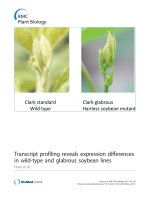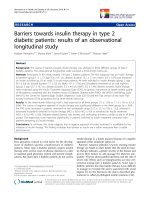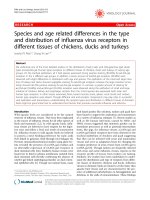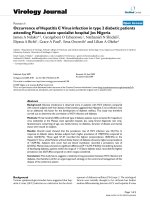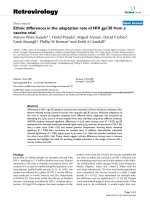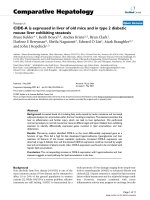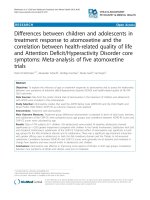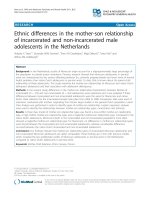Ethnic differences in response to rosiglitazone in asian type 2 diabetic subjects
Bạn đang xem bản rút gọn của tài liệu. Xem và tải ngay bản đầy đủ của tài liệu tại đây (717.24 KB, 207 trang )
ETHNIC DIFFERENCES
IN RESPONSE TO ROSIGLITAZONE IN
ASIAN TYPE 2 DIABETIC SUBJECTS
MYA THWAY TINT
M.B, B.S (YANGON)
A THESIS SUBMITTED FOR
THE DEGREE OF MASTER OF SCIENCE
DEPARTMENT OF MEDICINE
NATIONAL UNIVERSITY OF SINGAPORE
2009
Acknowledgements
I would like to express my gratitude and sincere appreciation to my supervisor Prof. Lee
Kok Onn for his guidance and supervision. It is impossible to reference the knowledge
and insights gained from ongoing conversations with him. I deeply appreciate his support
from the preliminary to the completion of this thesis.
I am grateful to my co-supervisor Dr Gan Shu Uin for her support and friendship. Her
advice has been invaluable on both an academic and a personal level, and her
encouragement enabled me to bypass the obstacles to the thesis completion.
I am indebted to Dr Stanley Liew who mentored me for the glucose clamp techniques. I
thank him for his insightful and helpful suggestions.
I am forever grateful to my parents, aunts, brothers and sisters for their unequivocal
support and love at each turn of the road throughout my study.
I would like to thank my husband and my daughter for their great support, understanding
and patience. My husband has always supported my dreams and aspirations. I am
thankful for who he is, and all he has done for me.
I also would like to thank the Head of Department and all staff at the Department of
Medicine for their support and assistance since the start of my graduate study.
I am very grateful to the staff of Endocrinology laboratory and Phoenix lab for their
kindness, friendship and assistance. Last but not least, I offer my kind regards and
gratitude to everyone who supported me in any respect till the completion of the thesis.
This thesis is dedicated to my Grandfather who passed away in 2008.
i
Table of Contents
Acknowledgements
i
Table of Contents
ii
SUMMARY
vi
List of Tables
viii
List of Figures
ix
Previously Presented Materials
xi
Abbreviations
xii
Chapter 1: Introduction
1
Chapter 2: Literature Review
9
2.1.
Ethnic Predisposition to Type 2 Diabetes
9
2.2.
Ethnic Difference in Insulin Sensitivity
13
2.3.
Adipose Tissue
15
2.4.
2.5.
2.3.1.
Adipose Tissue as Energy Storage Depot
15
2.3.2.
Adipose Tissue as Active Endocrine Organ
15
2.3.3.
Adipokines and Insulin Resistance
16
IGF Binding Protein-1 and Insulin Sensitivity
35
2.4.1.
Insulin-like Growth Factors I and II
35
2.4.2.
Insulin-like Growth Factor Binding Proteins
35
2.4.3.
IGFBPs and Insulin Sensitivity
36
Thiazolidinediones
37
2.5.1.
Mechanisms of Action of Thiazolidinediones
39
2.5.2.
Effect of Thiazolidinediones on Adipose Tissue
40
2.5.3.
Effect of Thiazolidinediones on Skeletal Muscle
41
2.5.4.
Effect of Thiazolidinediones on Liver
42
ii
2.5.5.
Effect of Thiazolidinediones on Pancreatic beta cells
43
2.5.6.
Effects of Thiazolidinediones on Lipids
44
2.5.7.
Effect of Thiazolidinediones on Anthropometry
45
2.5.8.
Effect of Thiazolidinediones on Adipokines
48
2.5.9.
Adverse Effects of Thiazolidinediones
51
Chapter 3. Materials and Methods
56
3.1.
Subjects
56
3.2.
Study Design
57
3.3.
Anthropometric measurements
58
3.3.1.
Body Mass Index
58
3.3.2.
Waist Hip Ratio
58
3.3.3.
Percentage Body Fat and Fat Free mass
59
3.4.
Euglycaemic, Hyperinsulinaemic Xlamp
59
3.5.
Measurement of Adiponectin
61
3.5.1.
Measurement of Total Adiponectin
61
3.5.2.
Measurement of High Molecular Weight Adiponectin
61
3.6.
Measurement of Other Adipokines
62
3.7.
Measurement of Insulin-Like Growth Factor Binding Protein-1
63
3.8.
Other Biochemical Analysis
64
3.9.
Statistical Analysis
65
Chapter 4. Results
66
4.1.
Demographic Characteristics of the Study Population
66
4.2.
Metabolic Characteristics of 2 Ethnic Groups
68
4.3.
Ethnic Difference in Anthropometry after 16 week Rosiglitazone Treatment
70
4.3.1.
Changes in Total Body Weight
70
iii
4.4.
4.3.2.
Changes in Body Mass Index
72
4.3.3.
Changes in Waist Circumference
74
4.3.4.
Changes in Waist Hip Ratio
76
Changes in Glycemic control after 16 week Rosiglitazone Treatment
80
4.4.1.
Changes in Fasting Plasma Glucose Levels
80
4.4.2.
Changes in Haemoglobin A1c
82
4.4.3.
Changes in Fasting Plasma Insulin Levels
84
4.5.
The Changes in the Lipid Profile after 16 week Rosiglitazone Treatment
86
4.6.
Changes in Insulin Sensitivity after 16 week Rosiglitazone Treatment
89
4.7.
Changes in Adiponectin
93
4.7.1.
Baseline Fasting Adiponectin levels
93
4.7.2.
Acute Adiponectin Changes during Euglycemic Hyperinsulinemic
Clamp
94
4.7.3.
4.8.
Changes in Fasting Adiponectin levels after 16 weeks Rosiglitazone
100
Treatment
Changes in the other adipokines
105
4.8.1.
Changes in Fasting Leptin levels
105
4.8.2.
Changes in Fasting Resistin Levels
107
4.8.3.
Changes in Fasting Tumor Necrosis Factor alpha Levels
109
4.8.4.
Changes in Fasting Interleukin-6 Levels
111
4.8.5.
Changes in Fasting Plasminogen Activator Inhibitor – 1 Levels
113
4.9.
Changes in Insulin-Like Growth Factor Binding Protein-1
115
4.9.1.
Baseline Fasting IGFBP-1 Levels
115
4.9.2.
The Dynamic Interaction between IGFBP-1 and Insulin Level
116
4.9.3.
The Changes in IGFBP-1 Level in Response to Rosiglitazone
120
iv
Chapter 5. Discussion and Conclusion
122
5.1.
Ethnic Differences in Insulin Sensitivity in Response to Rosiglitazone
123
5.2.
Ethnic Variation in Adiponectin
127
5.2.1.
Plasma Levels of Adiponectin
127
5.2.2.
Chronic Changes in Adiponectin in Response to Rosiglitazone
128
5.2.3.
Dynamic Suppression of Adiponectin during Euglycemic
Hyperinsulinemic clamp
129
5.3.
Ethnic Similarity in Insulin Iecretion
131
5.4.
Ethnic Variation in IGFBP-1 levels
133
5.4.1.
Plasma Levels of IGFBP-1
133
5.4.2.
Chronic Changes in IGFBP-1 in Response to Rosiglitazone
134
5.4.3.
Dynamic Suppression of IGFBP-1 during Euglycemic
Hyperinsulinemic Clamp
135
5.5.
Ethnic Similarity in Glycemic Control in Response to Rosiglitazone
137
5.6.
Ethnic Variation in Lipid Profile in Response to Rosiglitazone
138
5.7.
Changes in Proinflammatory Adipokines
139
Chapter 6. Conclusion
140
References
142
v
SUMMARY
Chinese and Asian Indians while both often described as “Asians”, show
significant differences in the prevalence of Type 2 Diabetes Mellitus (T2DM) and insulin
resistance. Thiazolidinediones act to improve the insulin sensitivity in T2DM. The main
objective of this study was to assess the effect of Rosiglitazone on the insulin sensitivity
of Asian type 2 diabetic patients of two different ethnic groups, Chinese and Indians. We
measured the insulin sensitivity in Asian type 2 diabetic subjects using euglycemic
hyperinsulinaemic clamp before and after 16 week treatment with 4 mg Rosiglitazone.
We studied the effect of Rosiglitazone on anthropometry, glycaemic control and insulin
sensitivity. We also studied various adipokines especially adiponectin in its different
molecular weight forms and other biochemical changes, including dynamic changes in
IGFBP-1.
Eighteen Asian type 2 diabetic patients participated in the study. All subjects
underwent a euglycemic-hyperinsulinemic glucose clamp before and after completion of
16-week Rosiglitazone treatment. The anthropometric and metabolic variables are
measured. Total and high molecular weight (HMW) adiponectin, and IGFBP-1 were
measured by commercially available ELISA kits. The various other adipokines were
measured using a novel Bio-Plex ProTM Human Diabetes Assay.
Our study showed that there was a significant ethnic difference in insulin
sensitivity in response to Rosiglitazone in Asian Indian type 2 diabetic patients compared
to Asian Chinese. Indians had greater improvement in insulin sensitivity despite greater
increase in total body weight and percent body fat, waist circumference and waist hip
vi
ratio. There was no ethnic difference in improvement in glycaemic control measured by
fasting plasma glucose, haemoglobin A1c between two ethnic groups.
Asian Indians had higher levels of total adiponectin and lower levels of high
molecular weight adiponectin compared to Chinese. However, Asian Indian type 2
diabetic subjects had a lower Adiponectin index compared to Chinese. This would
suggest that Adiponectin index may be a better indicator for insulin sensitivity in Asian
type 2 diabetic subjects. Both ethnic groups showed a similar increase in the Adiponectin
index after Rosiglitazone treatment but Asian Indians continued to have a significantly
lower Adiponectin index than Chinese even after the treatment. There was an acute
dynamic suppression of adiponectin, both total and high molecular weight, in both
Chinese and Indian type 2 diabetic patients undergoing euglycemic hyperinsulinemic
clamp. The suppression was similar before and after Rosiglitazone treatment in both
ethnic groups.
Asian type 2 diabetic patients had low levels of IGFBP-1 at the baseline despite
having low levels of insulin. The dynamic changes seen in IGFBP-1 in relation to serum
insulin (hysteresis loop) changed after Rosiglitazone treatment in both ethnic groups.
vii
List of Tables
Table 1. Baseline demographic characteristics of 2 ethnic groups
67
Table 2. Metabolic characteristics of 2 ethnic groups
69
Table 3. IGFBP-1 levels during euglycemic hyperinsulinemic clamp before
Rosiglitazone treatment
117
Table 4. IGFBP-1 levels during euglycemic hyperinsulinemic clamp after Rosiglitazone
treatment
117
viii
List of Figures
Figure 1.
The domain structures of monomeric adiponectin
20
Figure 2.
Model for assembly of adiponectin complexes
21
Figure 3.
Changes in total body weight after 16 week Rosiglitazone treatment
71
Figure 4.
Changes in body mass index after 16 week Rosiglitazone treatment
73
Figure 5.
Changes in Waist circumference after 16 week Rosiglitazone treatment
75
Figure 6.
Changes in Waist Hip Ratio after 16 week Rosiglitazone treatment
77
Figure 7.
Changes in body fat percentage after 16 week Rosiglitazone treatment
79
Figure 8.
Changes in fasting plasma glucose after 16 week Rosiglitazone treatment 81
Figure 9.
Changes in HbA1c after 16 week Rosiglitazone treatment
83
Figure 10. Changes in fasting insulin after 16 week Rosiglitazone treatment
85
Figure 11. Changes in lipid profile in Chinese after 16 week Rosiglitazone treatment 87
Figure 12. Changes in lipid profile in Indians after 16 week Rosiglitazone treatment 88
Figure 13. Ethnic difference in insulin sensitivity normalized for body weight
90
Figure 14. Ethnic difference in insulin sensitivity normalized for fat free mass
92
Figure 15. Acute changes in Total adiponectin before 16 week Rosiglitazone treatment
95
Figure 16. Acute changes in Total adiponectin after 16 week Rosiglitazone treatment
96
Figure 17. Acute changes in high molecular weight adiponectin before 16 week
Rosiglitazone treatment
98
Figure 18. Acute changes in high molecular weight adiponectin after 16 week
Rosiglitazone treatment
99
Figure 19. Changes in Total adiponectin and high molecular weight adiponectin in
Indians after 16 week Rosiglitazone treatment
101
Figure 20. Changes in Total adiponectin and high molecular weight adiponectin in
Chinese after 16 week Rosiglitazone treatment
102
Figure 21. Changes in Adiponectin Index after 16 week Rosiglitazone treatment
104
Figure 22. Changes in fasting Leptin after 16 week Rosiglitazone treatment
106
ix
Figure 23. Changes in fasting Resistin after 16 week Rosiglitazone treatment
108
Figure 24
Changes in fasting Tumor Necrosis Factor-alpha after 16 week
Rosiglitazone treatment
110
Figure 25. Changes in fasting Interleukin-6 after 16 week Rosiglitazone treatment
112
Figure 26. Changes in fasting Plasminogen Activator Inhibitor-1 after 16 week
Rosiglitazone treatment
114
Figure 27. Relationship between IGFBP-1 and insulin in Chinese during the
euglycemic clamp- before 16 week Rosiglitazone treatment
118
Figure 28. Relationship between IGFBP-1 and insulin in Chinese during the euglycemic
clamp- after 16 week Rosiglitazone treatment
118
Figure 29. Relationship between IGFBP-1 and insulin in Indian during the euglycemic
clamp- before 16 week Rosiglitazone treatment
119
Figure 30. Relationship between IGFBP-1 and insulin in Indian during the euglycemic
clamp- after 16 week Rosiglitazone treatment
119
Figure 31. Changes in fasting IGFBP-1 after 16 week Rosiglitazone treatment
121
x
Previously Presented Materials
MT Tint, E. Cunanan, A Hamidi, C.M. Khoo, K-O Lee, C-F Liew, Rosiglitazone
Increases Total And High Molecular Weight Adiponectin Despite Increase In Total Body
Weight In Asian Type 2 Diabetes Mellitus Patients. Poster for 14th Congress of the
ASEAN
Federation
of
Endocrine
Societies,
Kuala
Lumpur,
Malaysia;
November/December 2007
Mya T. Tint, Elaine Cunanan, Chin M. Khoo, Kok O. Lee, Choon F. Liew, Ethnic
Differences in Response to Rosiglitazone in Asian Type 2 Diabetes Mellitus Subjects.
Oral presentation for 68th Annual Scientific Sessions of American Diabetic
AssociationPage No. of Abstract, American Diabetic Association, San Francisco, United
States; June 2008
Mya T. Tint, Elaine Cunanan, Chin M. Khoo, Kok O. Lee, Choon F. Liew, Ethnic
Differences in Response to Rosiglitazone in Asian Type 2 Diabetes Mellitus Subjects
(Manuscript in preparation)
xi
Abbreviations
T2DM
Type 2 diabetes mellitus
PPAR
Paroxisome Proliferator Activated Receptors
PPAR-γ
Paroxisome Proliferator Activated Receptor- gamma
PPAR-α
Paroxisome Proliferator Activated Receptor- alpha
PPAR-δ
Paroxisome Proliferator Activated Receptor- delta
LMW
Low Molecular Weight
MMW
Middle Molecular Weight
HMW
High Molecular Weight
AdipoR1
Adiponectin Receptor-1
AdipoR2
Adiponectin Receptor-2
TNF-α
Tumor Necrosis Factor – alpha
IL-6
Interleukin - 6
PAI-1
Plasminogen Activator Inhibitor-1
IGF
Insulin like Growth Factor
IGFBP
Insulin like Growth Factor Binding Protein
IGFBP-1
Insulin like Growth Factor Binding Protein-1
BMI
Body Mass Index
WHR
Waist Hip Ratio
HbA1C
Haemoglobin A1c
HDL-C
High Density Lipoprotein Cholesterol
LDL-C
Low Density Lipoprotein Cholesterol
HOMA
Homeostasis Model Assessment
HOMA-IR
Homeostasis Model Assessment of Insulin Resistance
QUICKI
Quantitiative Insulin Sensitivity Check Index
DREAM
“Diabetes Reduction Assessment with Ramipril and Rosiglitazone
xii
Medication” Study
ADOPT
A Diabetes Outcome Progression Trial
ACCORD
“The Action to Control Cardiovascular Risk in Diabetes” trial
PROactive
“The Prospective Pioglitazone Clinical Trial in Macrovascular Events”
study
RECORD
“Rosiglitazone Evaluated for Cardiac Outcomes and Regulation of
Glycemia in Diabetes” study
xiii
Chapter 1: Introduction
The prevalence of diabetes has been increasing remarkably worldwide and is
projected to rise further in the first quarter of this century. A recent WHO report
estimated that the global burden of diabetes would more than double from 171 million in
2000 to 366 million in 2030(Wild et al., 2004) . India is estimated to have almost 80
million people with diabetes in 2030 from 31.7 million in 2000 and China is estimated to
have 42.3 million in 2030 from 20.8 million in 2000. The country with the highest
number of people with diabetes is estimated to be India followed by China (King et al.,
1998; King and Rewers, 1993; Wild et al., 2004). These ethnic groups, Chinese and
Asian Indians, while both often described as “Asians”, are fast becoming the two most
affected ethnic groups in the world in terms of diabetes.
Epidemiological studies has shown consistently that people from the Indian
subcontinent are peculiarly susceptible to diabetes mellitus and have a markedly
increased predisposition to cardiovascular disease compared to Caucasians even when
exposed to similar environmental condition (Joshi et al., 2007; Mather and Keen, 1985;
McKeigue et al., 1989; Ramachandran et al., 1992; Swinburn et al., 1991). Singapore has
a population with 3 major ethnic groups: Chinese, Malay and Indians. Singapore has one
of the highest prevalence of type 2 diabetes mellitus in the world. According to the
Singapore National Health survey 2004, the prevalence of diabetes in Singapore has
increased from 1.9 % in 1975 to 8.2 % in 2004 (Ministry of Health, 2004; Tan et al.,
1999). There is also an ethnic difference in the prevalence of type 2 diabetes mellitus in
Singapore. The prevalence is significantly higher among Indians compared to the other
ethnic groups, Chinese and Malays (Hong et al., 2004). The risk of ischaemic heart
disease associated with diabetes mellitus also differs between ethnic groups and the risk
1
in Indian is higher than for Chinese and Malays in Singapore (Heng et al., 2000; Yeo et
al., 2006). This ethnic difference cannot be explained by differences in classical risk
factors.
The pathogenesis of Type 2 Diabetes Mellitus (T2DM) is thought to involve
insulin resistance and insufficient insulin secretion from pancreatic beta cells. There is
evidence that the relative contribution of these 2 pathogenic factors is different in the
various ethnic groups (Laws et al., 1994; McKeigue et al., 1991). Asian Indians are
significantly more insulin resistant than other ethnic groups and the risk of diabetes starts
to increase rapidly at levels of body mass index or waist circumference well in the
acceptable range of body mass index or waist circumference for Caucasians. Therefore, it
is crucial to recognize insulin resistance especially in Asian Indians.
The accurate, reliable and reproducible quantification of insulin resistance in vivo
is clearly important for prevention, diagnosis, treatment, monitoring of the follow ups and
evaluation of the response to drugs in these Asian Indians. The euglycemic
hyperinsulinemic clamp technique is the gold standard method to measure insulin
sensitivity because it directly measures insulin action on glucose utilization under steadystate conditions (Bergman et al., 1985; Del Prato, 1999; Ferrannini and Mari, 1998). A
number of simple indices have been developed using fasting plasma glucose and insulin
concentrations to derive indices of insulin sensitivity from a mathematical model such as
the homeostasis model assessment (HOMA) (Matthews et al., 1985), the fasting insulin
resistance index (FIRI) (Duncan et al., 1995) and the quantitative insulin sensitivity check
index (QUICKI)(Katz et al., 2000) or index which measure their ratios (Rabasa-Lhoret
and Laville, 2001). These indices are indirect methods of measuring insulin sensitivity.
2
Although there may be good correlation of the results on insulin sensitivity between these
indices and euglycemic hyperinsulinemic clamp, none of the results obtained from these
indices reveal the exact same information as the direct measurement of insulin sensitivity
using euglycemic hyperinsulinemic clamp. In addition, in diabetic subjects, the
correlation of these indices and the euglycemic hyperinsulinemic clamp was much lower
than the non-diabetic population (Avignon et al., 1999; Matsuda and DeFronzo, 1999).
Therefore, the results from these indices can provide a misleading evaluation in type 2
diabetic patients where the fasting glucose and insulin levels may be very variable.
Currently, the euglycemic hyperinsulinemic clamp technique is the most frequently
applied technique and is accepted as the “gold standard” for the in vivo assessment of
insulin sensitivity especially in diabetics (Bergman et al., 1985; Del Prato, 1999;
Ferrannini and Mari, 1998).
A previous study in my supervisor’s laboratory used the euglycaemic
hyperinsulinaemic clamp technique to assess insulin sensitivity in healthy, lean,
nondiabetic young Asians living in Singapore and demonstrated that insulin sensitivity
was lower in Indians compared to Chinese and Caucasians (Liew et al., 2003). This
ethnic difference in insulin sensitivity may explain the epidemiological observation that
Asian Indians have a significantly higher prevalence of type 2 diabetes mellitus.
Thiazolidinediones or peroxisome proliferator-activated receptor-gamma (PPARγ)
agonists are a class of drugs for the treatment of T2DM, which act to improve the insulin
sensitivity of peripheral tissues (adipose tissue, liver and skeletal muscle) (O'MooreSullivan and Prins, 2002; Olefsky, 2000; Olefsky and Saltiel, 2000). Currently,
Rosiglitazone and Pioglitazone are the only two main thiazolidinediones available. The
3
thiazolidinediones increase peripheral glucose utilization in skeletal muscle, increase fatty
acid uptake and reduce lipolysis in adipose cells. This ultimately leads to a reduction in
fasting and post-prandial plasma glucose, insulin and circulating free fatty acid (FFA)
levels, thus sparing the toxic effects of FFA and glucose on liver and muscle (Olefsky,
2000).
Thiazolidinediones has been shown to lower HbA1c and fasting plasma glucose
levels when used as monotherapy or in combination with a sulfonylurea or metformin
(O'Moore-Sullivan and Prins, 2002). Only a few studies have used the euglycaemic clamp
to evaluate the effect of Rosiglitazone on the insulin sensitivity (Hallsten et al., 2002;
Miyazaki et al., 2001b). The addition of Pioglitazone to sulfonylurea-treated type 2
diabetic patients showed that Pioglitazone improved hepatic and peripheral tissue
sensitivity to insulin and thereby decreased fasting and postprandial plasma glucose levels
in type 2 diabetic patients (Miyazaki et al., 2001b). Rosiglitazone improves insulin
responsiveness in resting skeletal muscle and doubles the insulin-stimulated glucose
uptake rate during physical exercise in patients with T2DM. Among these few studies, the
majority involved T2DM patients of Caucasian origins (Hallsten et al., 2002).
Thiazolidinediones have also been shown to increase high density lipoprotein
cholesterol (HDL-C) and reduce triglycerides. Rosiglitazone has been reported to increase
low density lipoprotein cholesterol (LDL-C) slightly, primarily the larger buoyant form,
while decreasing small dense LDL-cholesterol (Lebovitz et al., 2001).
Thiazolidinediones may also ameliorate the insulin resistance by promoting
adipocyte differentiation and increasing the number of small adipocytes that are more
4
sensitive to insulin. In addition Thiazolidinediones favorably mediate the secretory profile
of the adipokines. Thiazolidinediones upregulate adiponectin by generating small
adipocytes that abundantly express and secrete adiponectin and/ or directly activating the
adiponectin gene transcription (Picard and Auwerx, 2002; Smith, 2003; Spiegelman,
1998). Adiponectin exerts a potentiating effect by binding to its receptor adiponectin
receptor-1 and adiponectin receptor-2, leading to activation of AMPK, thereby decreasing
gluconeogenesis in the liver and ameliorating insulin resistance(Tsuchida et al., 2004).
Adiponectin is a recently described collagen-like adipocytokine synthesized by
white adipose tissue. Adiponectin is abundant in human plasma, with concentrations
ranging from 2 to 20μg/ml, thus accounting for approximately 0.01% of total plasma
protein. This concentration is three orders of magnitude higher than concentrations of
most other hormones (Arita et al., 1999).
Adiponectin circulates in the plasma as trimeric, hexameric and high molecular
weight (HMW) forms.
Previous studies have suggested that different isoforms of
adiponectin have different biological activities (Pajvani et al., 2003; Tsao et al., 2003;
Waki et al., 2003). Although there is controversy over the relative biological activities
among these isoforms, studies have suggested that the HMW form may be more
biologically active compared to other lower molecular weight forms. It has been shown
that the adiponectin oligomer distribution, the ratio of high molecular weight to total
adiponectin, rather than its absolute levels may be more correlated with insulin sensitivity
(Pajvani et al., 2004).
Many studies have shown a relationship between adiponectin and insulin
sensitivity (Kubota et al., 2002; Takahashi et al., 2000). Lower plasma levels of
5
adiponectin have been documented in human subjects with obesity, type 2 diabetes
mellitus, or coronary artery disease (Arita et al., 1999; Hotta et al., 2000; Kumada et al.,
2003). Studies have demonstrated that treatment with Rosiglitazone in type 2 diabetic
patients increased plasma adiponectin levels (Yang et al., 2001) and also improved
insulin sensitivity and glycemic control and thus may potentially protect them from
macrovascular complications.
Rosiglitazone has also been shown to decrease circulating leptin (Miyazaki et al.,
2004), resistin (Jung et al., 2005) and pro-inflammatory adipocytokines such as tumor
necrosis factor-α (TNF- α), interleukin-6 (IL-6), (Kim et al., 2007), (Miyazaki and
Defronzo, 2008) and Plasminogen Activator inhibitor – 1 (PAI-1) levels (Dolezalova et
al., 2007) in patients with T2DM. Thus, through actions to enhance insulin-mediated
glucose uptake, through direct effects, or both, thiazolidinediones improve the metabolic,
vasoactive, inflammatory, and thrombotic milieu to potentially retard the atherosclerotic
process. These pleiotropic actions of thiazolidinediones have far-reaching implications
because type 2 diabetes and cardiovascular complications, such as coronary heart disease
and stroke, account for well over a third of all deaths in developed countries.
The insulin like growth factors (IGFs) are present in most body fluids and
circulate in the blood bound to specific binding proteins which modulate their activities
(Baxter, 1993; Rajaram et al., 1997; Rosenfeld et al., 1990; Shimasaki and Ling, 1991).
To date, a total of six IGF binding proteins (IGFBPs), IBFBP-1 to IGFBP-6 have been
identified. They are a family of related soluble proteins that bind IGF with high
specificity and affinity, and thereby regulate IGF dependent actions (Baxter, 2000; Firth
and Baxter, 2002; Zapf, 1995).
6
Previous studies have suggested that IGFBP-1 concentrations are inversely related
to insulin resistance or positively related to insulin sensitivity measured using either
homeostatic model assessment of insulin resistance (HOMA-IR) or euglycemic
hyperinsulinemic clamps. Studies in diabetic patients and non diabetic subjects have
consistently suggested that IGFBP-1 is inversely correlated with increased levels of
insulin and insulin resistance. However, with the exception of 1 early study (Suikkari et
al., 1988), the studies done on the dynamic changes in IGFBP-1 levels were on non
diabetic subjects. In addition, there are no studies done to determine the changes in
IGFBP-1 and ethnic difference in response to insulin sensitizers.
The effects of the thiazolidinediones on Asian populations with diverse ethnic
groups have not been much studied. There is scarcity of data on metabolic parameters and
responses to anti-diabetic medications in Asians compared to Western populations. In
addition, there have not been any studies which investigated the possible ethnic difference
in the response of subjects with T2DM to the administration of Rosiglitazone. Moreover,
a previous study has shown a significant difference in insulin resistance between local
non-diabetic Chinese and Indians. As thiazolidinediones act via the improvement of the
insulin resistance of individuals with T2DM, it is conceivable that there is also an ethnic
difference in its actions. To date, no published data is available on this issue.
7
Our present study aims to;
1.
To assess the effect of Rosiglitazone, a thiazolidinedione on the insulin sensitivity
of T2DM patients of two different ethnic groups (Chinese vs. Indian) using the
euglycaemic hyperinsulinaemic clamp.
2.
To assess the effects of Rosiglitazone on anthropometry, glycemic control,
adiponectin and IGFBP-1 of T2DM patients of different ethnic groups.
8
Chapter 2: Literature Review
2.1. Ethnic Predisposition to Type 2 Diabetes
The prevalence of diabetes in general and type 2 diabetes in particular, has
increased over the years at an alarming rate in all Western countries. Similar trends have
been observed in developing countries which are adopting a 'western life style'. This trend
suggests the impact of environmental factors such as diet, obesity and physical activity on
the pathogenesis of diabetes.
The increase in diabetes varies in different ethnic groups. The WHO Ad Hoc
diabetes report (1993) showed that within the chosen age range, diabetes was absent or
rare (< 3%) in certain traditional communities in developing countries. Age-standardized
prevalence varied from 3 to 10% in European populations and as high as 14 to 20% in
migrant Asian Indian, Chinese, and Hispanic American populations. Type 2 diabetes was
virtually unknown in rural Papua New Guinea (King and Rewers, 1993). In addition,
studies conducted in multiethnic populations suggest that some ethnic groups such as
Asian Indians might have a particular predisposition possibly on a genetic basis to
develop type 2 diabetes when exposed to adverse environmental conditions. It is well
known that Pima Indians of Arizona have the highest prevalence of Diabetes
(Ramachandran et al., 1992). However these Pima Indians in Arizona, who are
genetically related to those living in Northern Mexico, have a much higher prevalence of
diabetes compared with the Mexican Pima Indians, 54% and 37% vs. 6% and 11% for
men and women, respectively (Ravussin et al., 1994).
9
China, the largest developing country has experienced a fast socio-economic
development in recent decades which has resulted in rapid modernization and
urbanization. Simultaneously, the prevalence of diabetes in Chinese adults increased
markedly. In the national diabetes surveys, the prevalence of diabetes in the Chinese adult
population has increased from approximately 1% in 1980 to 2.5% in 1994 (Pan et al.,
1997). Then in the International Collaborative Study of Cardiovascular Disease in Asia
conducted from 2000 to 2001, the prevalence had increased to more than 5%. In addition
the results indicated that the prevalence was higher in urban, 7.8% compared to rural
areas, 5.1% (Gu et al., 2003). Another population-based cross-sectional study of diabetes
in Qingdao city showed a similar trend that prevalence was higher in the urban, 6.9%,
compared to the rural population, 5.6% (Dong et al., 2005). Chinese in Hong Kong and
Taiwan have 1.5 and 2.0 fold increased risk of diabetes compared to mainland
counterparts, (Wong and Wang, 2006). Other national surveys consisting of Chinese in
Singapore (Cutter et al., 2001; Thai et al., 1987) and Mauritius (Soderberg et al., 2005)
showed 7-10% prevalence of diabetes which is comparable to those reported in other
Chinese populations living in Westernized countries.
India, the country with second largest population has also witnessed impressive
economic and industrial development over the years. This industrialization has benefited
the population in terms of a better living standard. However, the darker side of this
advancement seems to be an increase in the incidence of lifestyle related disease,
especially type 2 diabetes mellitus. A rising prevalence of type 2 diabetes has been noted
in India since 1986 (Verma et al., 1986). A series of cross sectional surveys showed a
rising trend in the prevalence of diabetes. The percentage of type 2 diabetic subjects
increased from 5.2% in 1984 to 8.2% in 1995, 13.9% in 2000 and 18.6% in 2006
10
(Ramachandran et al., 1988; Ramachandran et al., 1992; Ramachandran et al., 1997). The
prevalence of diabetes in southern India showed wide differences in the urban and the
rural populations. Asian–Indians living in rural areas of India have a prevalence of
diabetes of about 2.4%. Asian Indians living in urban India like areas of Madras have a
prevalence of diabetes of about 8.2% (Ramachandran et al., 2008; Ramachandran et al.,
1992; Ramachandran et al., 2001; Ramachandran et al., 1997). A study from India
(Tripathy et al., 1971) and the multicentre study by the Indian Council of medical
Research (Ramaiya et al., 1990) have also shown a similar trend that the prevalence of
diabetes is higher in urban areas compared to rural areas.
Singapore has moved from the third world to the first world in terms of
significantly elevating the standard of living of the population. This rapid transformation
has presented important health challenges, such as a 4-fold increase in diabetes prevalence
from 1.9% in 1975 to 8.2% in 2004. Singapore has a population with 3 major ethnic
groups: Chinese (75.2%), Malay (13.6%) and Indians (8.8%). These Chinese and Indians
were migrants from their native countries dating back to the 19th and 20th centuries. Of
the Indians, 80% originate from the southern states of India. There has been an increasing
prevalence of diabetes in Singapore from 1.99% in 1975 to 4.7% in 1984 and further
increase to 8.2% in 2004 (Cheah et al., 1985; Hong et al., 2004; Thai et al., 1987). The
increase in prevalence occurred in Chinese (4% in 1984 to 7.1% in 2004), Malays (7.6%
in 1984 to 11% in 2004) and Indians (8.9 % in 1984 to 15.3% in 2004). The most
prominent increase was in the Indians with an increase of 72%. This may indicate a
genetic predisposition among the Indians, in addition to the effect of migration, as a high
prevalence of diabetes has been found among migrant Asian Indians in many countries
(Anand et al., 2000; Mather and Keen, 1985; Samanta et al., 1987; Simmons et al., 1989)
11

